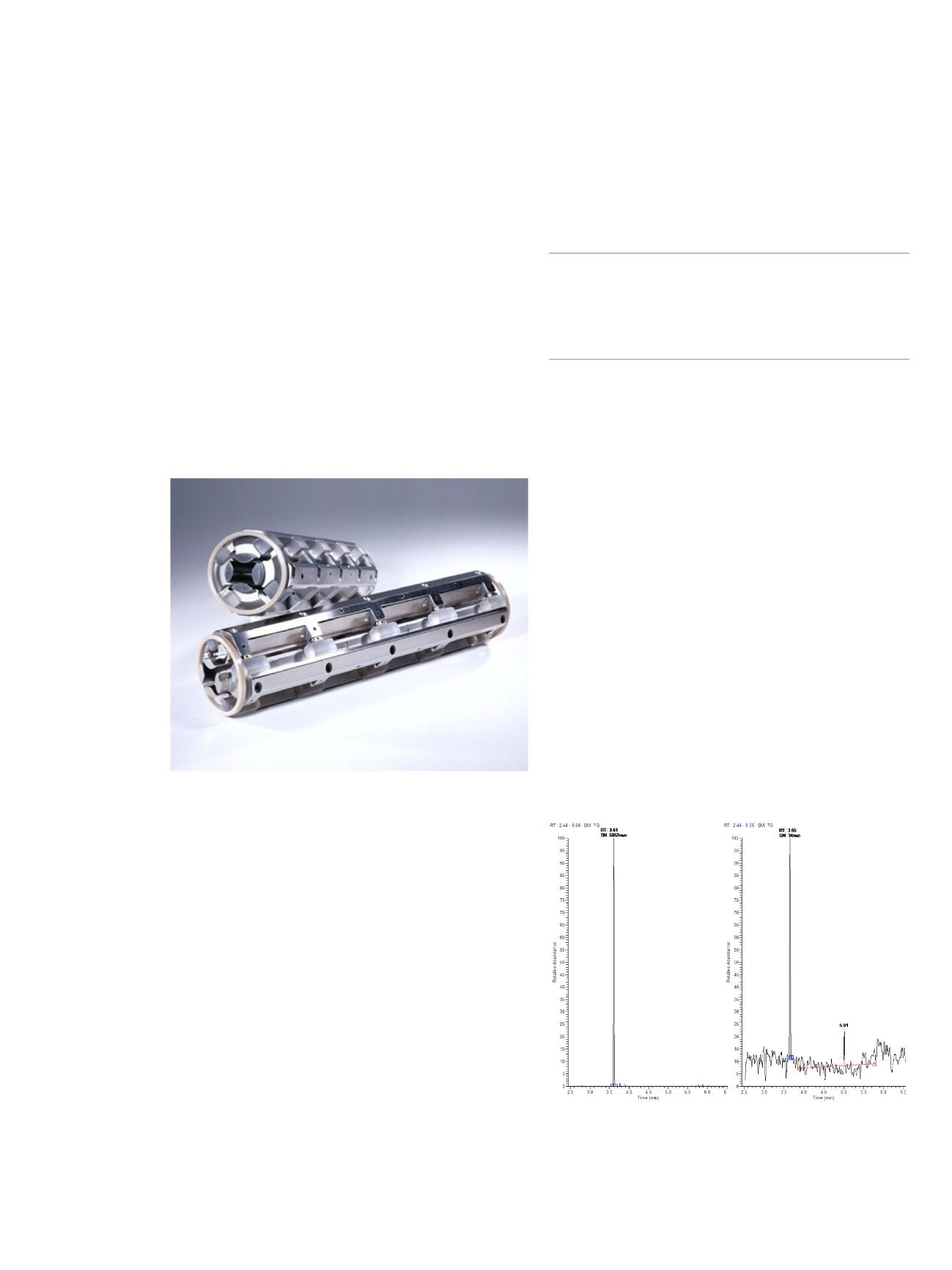
2
interferences in the analysis. The same effect can be
observed when mass resolution settings of 1.2 Da FWHM
or higher are used during single quadrupole analysis. This
can be seemingly effective when simple sample matrices
are encountered. However, when facing a more complex
sample matrix this strategy can cause problems in the
analysis.
What are Isobaric Interferences?
The term “isobaric interferences” describes ions of the
same nominal mass but of different chemical composition
and structure. The “nominal mass” is typically the mass
used in quadrupole instruments for programming SIM or
SRM acquisition. This reflects the typical unit mass
resolution capabilities of standard quadrupole instru-
ments. The nominal mass, in this context, can be
described as a 1 Da (1
m/z
) resolution capability between
mass peaks. The term “isobaric interference” means in
practice that ion signals from other compounds than the
target analyte appear at the same nominal mass in the
scan spectrum, the SIM trace or, in some cases, the SRM
trace.
For triple quadrupole instruments operated in SRM
mode, the selectivity is generally high. This is due to the
MS/MS process. There are cases, however, where despite
MS/MS being applied, selectivity is challenged. These
cases appear more frequently when the matrix load of
samples is very high. This is not unusual for a triple
quadrupole, as often the most complex quantitative
determinations are directed to this type of technology. The
likelihood of encountering a full SRM interference
increases as a function of the matrix complexity. The
observed effects of isobaric interferences are also more
apparent when targeting compounds in low or sub-ppb
concentration ranges. This is because the target com-
pound mass is more likely to be “shadowed” by
interfering matrix ions (especially in the first stage of MS
in Q1) that are typically orders of magnitude higher in
concentration. The drive towards shorter clean-up
procedures also pushes additional matrix to the detection
system, adding to the problem.
When these intense interfering matrix ions successfully
transmit through Q1 into the collision cell, there is a
higher statistical probability that interfering product ion
masses are formed. This gives rise to a higher occurrence
of full SRM interferences and visibly reduced analyte
selectivity. This often manifests as an increased chemical
noise background and hence, low signal-to-noise detec-
tion. This is observed most frequently in matrix samples
and is often unnoticed or absent in solvent only standards
(see Figure 3). Because solvent standards are relatively
clean, it is also possible (and sometimes practiced) to open
Q1 above unit mass resolution (so called “wide” or
“open” settings.) This creates the possibility to gain
sensitivity, but does not help much when considering real
backgrounds in complex samples. Sensitivity (and
selectivity) achieved at wider Q1 resolution values can
vary considerably between clean and dirty samples. With
that in mind, it is sensible that any comparisons between
instruments, especially those that are to face dirtier
samples, are performed in matrix samples. If solvent
standards are to be used, then the true instrument
sensitivity should be compared using equivalent Q1 and
Q3 resolution values.
How Triple Quadrupole Analyzers Work
The idea of using three quadrupoles arranged in series in a
triple quadrupole analyzer for structure elucidation (“an
added dimension of mass spectral information”) follows
an idea first reported by Richard Yost and Chris Enke of
Florida University in 1970. The analyzer should allow the
detection of structure-related information and overcome
the single quadrupole limitation of measuring a mass
The observed effects of isobaric
interferences are also more apparent when
targeting compounds in low or sub-ppb
concentration ranges.
Figure 2. HyperQuad quadrupole rods used in the TSQ Quantum
XLS Ultra system
Figure 3. High occurrence of matrix interference on standard
specification compound (octafluoronapthalene) with “Wide/
Open” Q1 settings (1.2 Da FWHM) absent in solvent standard
(left) but significant when in presence of complex matrix (right).
1.2 Da wide resolution
100 fg/µL in
clean solvent
1.2 Da wide resolution
100 fg/µL in diesel
matrix


